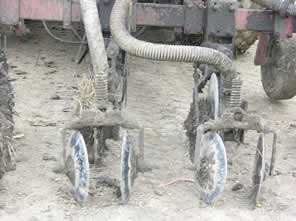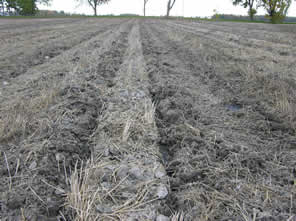
Putting Manure in it's Place
You have liquid manure and you would like to get the most nutrient bang for your buck. Injecting the manure directly into the ground is an approach that may have a significant impact on the amount of nitrogen available for next years corn crop. Consider an example of some of the decision making that is associated with manure application systems.
In the process of improving manure use efficiency the first step is to get a manure sample that is representative of your manure supply and have it analyzed for nutrient content. In this example the manure analysis tells you that the total nitrogen content is 50 lbs of N per 1000 gallons of manure. This includes both the organic fraction (20 lbs N/1000 gallons) and the ammonium fraction (30 lbs N/1000 gallons). The rather stable organic fraction will not be affected by the method of application as these organic compounds breakdown gradually to release nitrogen into the plant-available form. The ammonium fraction of the manure will start to volatilize into the air as soon as it has been applied to the field. If this manure was applied in the late fall and incorporated within 24 hours the OMAFRA estimates indicate that 40% of the total N would be available to next years corn crop. If the application rate is 3,000 gallons per acre the math looks like this:
3,0000 gal. x 50 lbs N /1000 gal. x .40 = 60 lbs N/ acre (available to corn crop)
This estimate is based on several assumptions, one of which is the loss of N through ammonia volatilization in the 24 hour period between application and incorporation. For late fall applications this loss is estimated at 25% of the ammonium N in the manure. If the manure was injected rather than broadcast and incorporated this loss could be virtually eliminated. In this example it would represent reduced nitrogen losses of about 23 lbs N/acre. Of course not all of this available nitrogen will make it to next years corn crop, but assume 70% does. If this is the case an additional 16 lbs of N would be supplied to next years corn crop. Remember, nitrogen losses from the ammonium form can vary widely with conditions at the time of manure application. For example, if conditions were warm (> 25 C) and the soil was dry the volatilization losses may reach 50% of the ammonium fraction rather than the 25 % used in this example.
Middlesex Soil and Crop Improvement association has a research and demonstration project underway that is attempting verify some of these estimates. Dean Van Arenthals from Lucan is one of the co-operators in this project and is using his new manure tanker to set-up plots which compare broadcasting and incorporating to direct injection. Figure 1 shows Van Arenthals’ unit with the s-tine injecting system.
 |
Research from Ohio has also been comparing manure injection systems. E. Oekler and G. Graham summarized their 2003 results by indicating significantly higher corn yields where manure was injected compared to surface application. In this trial fall injection of manure produced corn yields of 169 bushels/acre, surface manure application yielded 152 bu/ac, and fertilizer N applied through the planter (120 lbs N/acre) yielded 167 bu/ac. It should be pointed out that in this study the fall surface applied manure was not incorporated. The manure application rate in this study was selected so as to meet all of the corn crop N requirements, as no supplemental fertilizer N was applied to the plots that received manure.
Other factors to consider in regard to manure injection systems:
Some injection toolbar designs may also be used as a sidedress toolbar if your circumstances present some opportunities for sidedressing manure in corn in June. Doug Schneider of Fullarton has been sidedressing manure in corn for years with Yetter knives on the back of his tanker, closing discs mounted on the back of theses knives do a reasonable job of covering manure in fall application situations as well (See Figure 3 and 4).
| Figure 2 |
 |
| Figure 3 |
 |
| Figure 4 |
 |
Captions